

STEP BY STEP EXAMPLES OF REACT HOOKS. Hooks allows us to add state to a functional component.

Using Hooks Requires react "next" So, use "next" in your package.json to get the latest version of it. Microsoft/TypeScript-React-Starter: A starter template for TypeScript and React with a detailed README describing how to use the two together. Introcution à Redux · Teaching. Written by Yoann Pigné on Updated on Redux ( est une bibliothèque JS permettant de gérer l’état d’une application de manière déterministe.
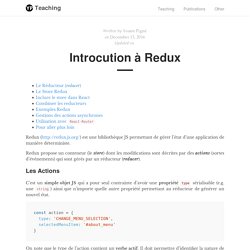
Redux propose un conteneur (le store) dont les modifications sont décrites par des actions (sortes d’évènements) qui sont gérés par un réducteur (reducer). Les Actions C’est un simple objet JS qui a pour seul contrainte d’avoir une propriété type sérialisable (e.g. une string) ainsi que n’importe quelle autre propriété permettant au réducteur de générer un nouvel état. On note que le type de l’action contient un verbe actif.
React & React-Native - Yann Vasseur. Hello, back on my blog.
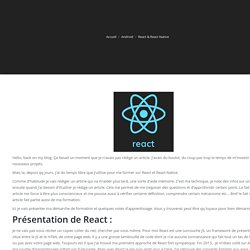
Ça faisait un moment que je n’avais pas rédigé un article. J’avais du boulot, du coup pas trop le temps de m’investir sur de nouveaux projets. Real world Higher-Order Components (HOCs) - Jakob Lind. Trying to wrap your head around React HOCs?
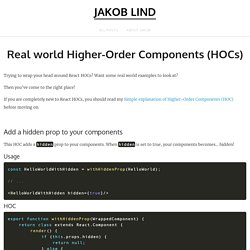
Want some real world examples to look at? Then you’ve come to the right place! If you are completely new to React HOCs, you should read my Simple explanation of Higher-Order Components (HOC) before moving on. Add a hidden prop to your components This HOC adds a hidden prop to your components. React Stateless Functional Components - Best Practices · JSTwister - Javascript unit testing and refactoring. React offers multiple way of creating re-usable components, but which one to use, when and why depends on a number of factors.
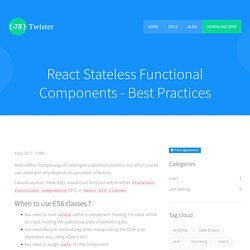
I would say that, these days, you should limit yourself, to either Stateless functional components(SFC) or React ES6 classes. When to use ES6 classes ? You need to have state within a component: holding the value within an input, holding the open/close state of something etcYou need lifecycle methods( eg when manipulating the DOM in an imperative way, using JQuery etc )You need to assign refs for the component When to use SFCs and why ? If the above 3 points don’t apply to your use case then you can safely use a stateless functional component. Storybook.js. By default, Storybook comes with a way to list stories and visualize them.
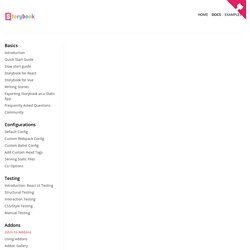
Addons implement extra features for Storybooks to make them more useful. Basically, there are two types of addons. (Decorators and Native Addons) 1. Decorators Decorators are wrapper components or Storybook decorators that wrap a story. Wrapper Components For example, let’s say we want to center a story rendered on the screen. Then we can use it when writing stories. Optimizing loading time for big React apps – Frontend Weekly – Medium. Load just what you need A big problem with named imports in ES6 is that you are importing the whole library and then destructuring it to access the module you need.
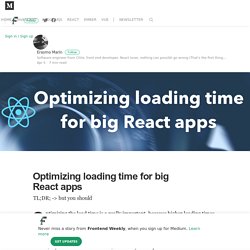
For small libs it’s ok, you will not notice any change, but for big dependencies, like lodash or ramda, I encourage you to just import what you need. ReactJS best practices for 2016 (première partie) - JS-Republic's Blog. 9 things every React.js beginner should know - Cam Jackson. I've been using React.js for about 6 months now.
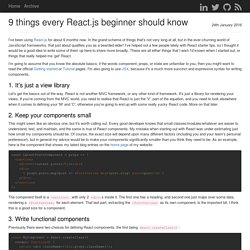
In the grand scheme of things that's not very long at all, but in the ever-churning world of JavaScript frameworks, that just about qualifies you as a bearded elder! I've helped out a few people lately with React starter tips, so I thought it would be a good idea to write some of them up here to share more broadly.
These are all either things that I wish I'd known when I started out, or things that really helped me 'get' React. I'm going to assume that you know the absolute basics; if the words component, props, or state are unfamiliar to you, then you might want to read the official Getting started or Tutorial pages. I'm also going to use JSX, because it's a much more succinct and expressive syntax for writing components. 1. Let's get the basics out of the way. 2. This might seem like an obvious one, but it's worth calling out.
The component itself is a <section>, with only 2 <div>s inside it. 3. ... and the other being ES6 classes: 4. REACT - Validation des formulaires. React on ES6+ · Babel. Posted Jun 7, 2015 by Steven Luscher This is a guest post from Steven Luscher.

Steven works on Relay at Facebook – a JavaScript framework for building applications using React and GraphQL. Follow Steven on Instagram, GitHub, and Twitter. While redesigning Instagram Web from the inside out this year, we enjoyed using a number of ES6+ features to write our React components. Allow me to highlight some of the ways that these new language features can change the way you write a React app, making it easier and more fun than ever. Classes By far the most outwardly visible change to how we write React components using ES6+ comes about when we choose to use the class definition syntax. Class Photo extends React.Component { render() { return <img alt={this.props.caption} src={this.props.src} />; }} Right away, you'll notice a subtle difference – a more terse syntax is available to you when defining classes: // The ES6+ wayclass Photo extends React.Component { handleDoubleTap(e) { … } render() { … }}
GitHub - enaqx/awesome-react: A collection of awesome things regarding React ecosystem. React Intro. 39 Form Examples with ReactJS. CR React Europe Conférence 2015 - Day 1. Après la première conférence officielle sur React, que nous avons déjà couvert en janvier (Jour 1 et Jour 2), nous nous sommes rendus les 2 et 3 juillet à Paris sous une chaleur infernale pour cette première édition de la React Europe avec l’envie de voir et de mesurer les évolutions autour de ReactJS.
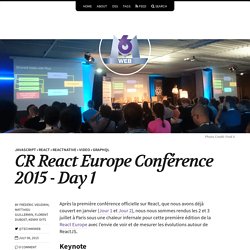
Au départ, React c’était simplement le V de MVC. Maintenant, on parle de “View First” ou “ User interface First”. Christopher Chedeaux @vjeux, l’un des core-dev de React, va faire un focus sur 4 axes principaux : Data Language Packager Targets 1) Data Depuis l’annonce de Flux ont fleuri beaucoup d’autres implémentations du pattern, notamment : D’après Christopher, certaines vont mourir dans les prochains mois laissant seulement la place aux implémentations les plus pertinentes (et Redux a fait un buzz sans pareil lors de ces 2 jours, voir plus bas). L’immuabilité revient aussi énormément en regardant du coté de ClojureScript ou ImmutableJS.
Application Architecture for Building User Interfaces. Flux is the application architecture that Facebook uses for building client-side web applications. It complements React's composable view components by utilizing a unidirectional data flow. It's more of a pattern rather than a formal framework, and you can start using Flux immediately without a lot of new code. Flux applications have three major parts: the dispatcher, the stores, and the views (React components). These should not be confused with Model-View-Controller. Controllers do exist in a Flux application, but they are controller-views — views often found at the top of the hierarchy that retrieve data from the stores and pass this data down to their children. Flux eschews MVC in favor of a unidirectional data flow. We originally set out to deal correctly with derived data: for example, we wanted to show an unread count for message threads while another view showed a list of threads, with the unread ones highlighted.
Read Me. Thinking in React. Edit on GitHub React is, in our opinion, the premier way to build big, fast Web apps with JavaScript. It has scaled very well for us at Facebook and Instagram. One of the many great parts of React is how it makes you think about apps as you build them. In this document, we'll walk you through the thought process of building a searchable product data table using React.
React – comment j’ai appris à ne plus m’en faire et à aimer la bombe. Javascript/react at master · airbnb/javascript. Complementary Tools · facebook/react Wiki. React is a small library that does one thing well. Here's a list of tools we've found that work really well with React when building applications. If you want your project on this list, or think one of these projects should be removed, feel free to edit this page.
Debugging Atellier: The smartest way to share interactive components with your team.React Developer Tools: an extension available for Chrome and Firefox that allows you to inspect the React component hierarchy in the Chrome Developer Tools.Pretty Diff: a beautifier that supports JSX and can auto-detect it apart from JavaScript. It provides some minimal level of scope analysis by generating a colorful HTML result to identify variables against the scope where they are declared. Choisir une architecture Flux pour son projet React. Kriasoft/react-starter-kit.